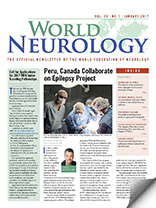By John D. England, MD
Within the first few months of 2017, the Journal of the Neurological Sciences will begin using EVISE, which is Elsevier’s new web-based editorial system. EVISE will replace the older system, the Elsevier Editorial System (EES). For more than a decade, the journal has been using EES to submit and manage manuscripts, but EES has gradually become outdated. We are hopeful that EVISE will provide an improved author and reviewer experience by enhancing editorial speed and increasing quality content. Since all of the Elsevier journals will eventually use EVISE, authors and reviewers will be able to access all of the Elsevier journals using a single sign-on. For authors, the submission process will be simplified, and proofing of articles will be faster. For reviewers, automated reference-linking to the bibliographic record will be available via CrossRef. Once deployment is accomplished, the journal’s EVISE page can be accessed via the “Submit Your Paper” link on the left of the journal’s home page. We expect that the new system will help both authors and reviewers streamline their tasks.
In our ongoing attempt to inform readers of important and interesting new developments in the journal, the editorial staff has selected two new “free-access” articles for our readership. The new selected articles provide a theoretical and experimental basis of a possible new treatment for carbon monoxide (CO) poisoning using methane-rich saline (MRS).
1. Methane has been reported to exert a protective role in ischemia-reperfusion injury of liver and heart via anti-oxidative, anti-inflammatory, and anti-apoptotic activities. As these same processes are thought to be responsible for brain injury associated with CO poisoning, Meihua Shen and colleagues studied the effects of MRS in the brains of rats that underwent experimental CO poisoning. The MRS was administered intraperitoneally after CO poisoning. MRS was able to protect the brain from CO injury as indicated by decreased neuronal injury. Measures of lipid peroxidation, DNA oxidative stress, and inflammatory factors were all decreased, suggesting that the neuroprotective effects of MRS are mediated by its anti-oxidative and anti-inflammatory activities.
Meihua Shen, et al., Neuroprotective effects of methane-rich saline on experimental acute carbon monoxide toxicity, J. Neurol. Sci. 369 (2016) 361-367. researchgate.net/publication/308017578_Neuroprotective_effects_of_methane-rich_saline_on_experimental_acute_carbon_monoxide_toxicity
2. In an accompanying editorial, Seref Kerem Corbacioglu comments on the potential significance of using MRS as a potential new treatment option in CO poisoning. He points out that CO poisoning is one of the most important causes of poisoning-related death and neurological damage in the world. At present, the only treatment for patients with CO poisoning is hyperbaric oxygen therapy, and this treatment remains somewhat controversial. Therefore, a safe and potentially better option to prevent the brain injury from CO toxicity is needed. Whether methane treatment in one form or another
will satisfy this need is an open question. The answer will require additional studies in animals and humans. The preliminary data would seem to indicate that such studies should proceed.
Seref Kerem Corbacioglu, New potential-treatment options in brain injury due to acute carbon monoxide poisoning in the future, J. Neurol. Sci. 369 (2016) 292-293. jns-journal.com/article/S0022-510X(16)30547-0/references

